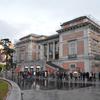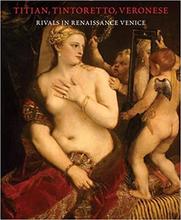More about The Washing of the Feet
- All
- Info
- Shop

Sr. Editor
While we can't definitively say Tintoretto was into feet, he did often return to the biblical story in which Christ washes the feet of his disciples as a subject for his art, as seen here in The Washing of the Feet.
Tintoretto painted The Washing of the Feet for the San Marcuola church, as a companion painting to his take on another bible story, The Last Supper (though you're probably more familiar with Leonardo da Vinci's version of that famous scene).
The painting was originally displayed on the right side of the altar at San Marcuola, which explains the unique positioning of the figures. Normally, Jesus would be front and center in his own story, but in this piece he's hanging out on the right with St. Peter. Churchgoers would have to look sideways to consider this tableaux, and from this perspective the geometry of the painted floor tiles, and the gaze of the other disciples (and the dog!) would create a linear emphasis on Jesus as the star of the show. On the way, your line of vision would encounter a humorous diversion: the disciples in the center of the room goofily struggling to remove their stockings for the ritual.
Foot washing (also called Maundy, or Pedelavium) is a common religious rite in various sects of Christianity. The story here goes that Jesus, in a gesture of humility and service, washes the feet of his disciples. According to John, Jesus reminded his followers to "pay it forward," so to speak:
"If I then, your Lord and Teacher, have washed your feet, you also ought to wash one another's feet. For I have given you an example, that you should do as I have done to you. Most assuredly, I say to you, a servant is not greater than his master; nor is he who is sent greater than he who sent him. If you know these things, blessed are you if you do them." (John 13:14–17)
Basically, you must not only receive the pedi, but also must give the pedi unto others.
The Washing of the Feet was removed in 1648 and replaced with a copy painted by Carlo Ridolfi, an Italian art writer who also dabbled in creating his own work. The copy still hangs in the San Marcuola, but the fate of the original is contested. There is another painting quite similar to this one in the collection of the Shipley Art Gallery, and there is disagreement among historians as to how much of either work was actually done by Tintoretto himself, as opposed to completed by the artists he employed in his workshop. In any case, Shipley insists that their version is the one that originally hung at the church's altar, and many people agree. However, the provenance of both works include some missing years, so it can't be proven beyond a reasonable doubt.
Sources
- Bishop, Brian Leslie, The Continuing Dialogue: An Investigation into the Artistic Afterlife of the Five Narratives Peculiar to the Fourth Gospel and an Assessment of Their Contributions to the Hermeneutics of that Gospel. Eugene: Resource Publications, 20
- Kimmelman, Michael, “Lights! Darks! Action! Cut! Maestro of Mise-en-Scene,” The New York Times, March 1, 2007. Date accessed July 15, 2020. https://www.nytimes.com/2007/03/01/arts/design/01tint.html
- Ridolfi, Carlo, “Lives of Tintoretto,” Lives of Tintoretto, edited by Giorgio Vasari. Los Angeles: Getty Publications, 2019.
- Thackara, Tess, “Tintoretto was the unsung hero of the Venetian Renaissance,” Artsy, February 19, 2019. Date accessed July 15, 2020. https://www.artsy.net/article/artsy-editorial-tintoretto-unsung-hero-ve…
Featured Content
Here is what Wikipedia says about The Washing of the Feet
The Washing of the Feet or El Lavatorio is a work by the Venetian artist Tintoretto which he produced between 1548 and 1549. It is considered one of his finest works. It is currently on display in the Museo del Prado.
Check out the full Wikipedia article about The Washing of the Feet















